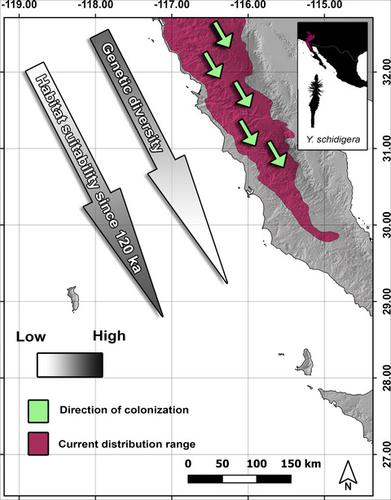当前位置:
X-MOL 学术
›
Plant Biol.
›
论文详情
Our official English website, www.x-mol.net, welcomes your feedback! (Note: you will need to create a separate account there.)
Genetic patterns and changes in availability of suitable habitat support a colonisation history of a North American perennial plant.
Plant Biology ( IF 3.9 ) Pub Date : 2019-12-06 , DOI: 10.1111/plb.13053 L De la Rosa-Conroy 1 , J Gasca-Pineda 1 , R Bello-Bedoy 2 , L E Eguiarte 3 , M C Arteaga 1
Plant Biology ( IF 3.9 ) Pub Date : 2019-12-06 , DOI: 10.1111/plb.13053 L De la Rosa-Conroy 1 , J Gasca-Pineda 1 , R Bello-Bedoy 2 , L E Eguiarte 3 , M C Arteaga 1
Affiliation

|
Climatic fluctuations during the Pleistocene influenced the geographical distribution of plant species across the southern region of California. Following an integrative approach, we combined genetic data analysis with Environmental Niche Models (ENMs) to assess the historical range expansion of Yucca schidigera, a long-lived desert perennial native of the Baja California Peninsula. We genotyped 240 individuals with seven nuclear microsatellite to investigate genetic diversity distribution across 13 populations. Indeed, we used Environmental Niche Models to examine the changes on the distribution of suitable climatic conditions for this species during the LIG (~120 ka), LGM (~22 ka) and Mid Holocene (~6 ka). We detected high genetic diversity across Y. schidigera populations (AR = 9.94 ± 0.38 SE; Hexp = 0.791 ± 0.011 SE) with genetic variation decreasing significantly with latitude (allelic richness: R 2 = 0.38, P = 0.023; expected heterocigosity: R2 = 0.32, P = 0.042). We observed low, but significant genetic differentiation (FST = 0.0678; P < 0.001) which was consistent with the parapatric distribution of the three genetic groupings detected by the Bayesian clustering algorithm. The ENMs suggest that suitable habitat for this species increased since the LGM. Our results support a range expansion of Y. schidigera across northwestern Baja California during the late Quaternary. Genetic data suggest that colonization of the current distribution followed a southward directionality as suitable climatic conditions became widely available in this region. High genetic variation across our sample suggests large historic effective population sizes for this section of the geographical range.
中文翻译:

遗传模式和合适生境可用性的变化支持了北美多年生植物的定殖历史。
更新世期间的气候波动影响了加利福尼亚南部地区植物物种的地理分布。通过综合方法,我们将遗传数据分析与环境生态位模型(ENM)结合起来,以评估丝兰(Yucca schidigera)的历史范围扩展,该丝科是巴哈加州半岛的长寿沙漠多年生原生植物。我们对240个具有7个核微卫星的个体进行了基因分型,以研究13个种群之间的遗传多样性分布。实际上,我们使用环境生态位模型研究了该物种在LIG(〜120 ka),LGM(〜22 ka)和中全新世(〜6 ka)期间适宜气候条件的分布变化。我们在裂殖酵母种群中检测到高遗传多样性(AR = 9.94±0.38 SE; Hexp = 0.791±0。011 SE),且遗传变异随纬度显着降低(等位基因丰富度:R 2 = 0.38,P = 0.023;预期异源性:R2 = 0.32,P = 0.042)。我们观察到了低但显着的遗传分化(FST = 0.0678; P <0.001),这与通过贝叶斯聚类算法检测到的三个遗传分组的同族分布是一致的。ENMs表明,自LGM以来,该物种的合适栖息地有所增加。我们的结果支持第四纪晚期第四纪裂殖酵母在整个下加利福尼亚州西北部的范围扩展。遗传数据表明,随着合适的气候条件在该地区广泛使用,当前分布的定殖遵循了向南的方向性。
更新日期:2019-12-06
中文翻译:

遗传模式和合适生境可用性的变化支持了北美多年生植物的定殖历史。
更新世期间的气候波动影响了加利福尼亚南部地区植物物种的地理分布。通过综合方法,我们将遗传数据分析与环境生态位模型(ENM)结合起来,以评估丝兰(Yucca schidigera)的历史范围扩展,该丝科是巴哈加州半岛的长寿沙漠多年生原生植物。我们对240个具有7个核微卫星的个体进行了基因分型,以研究13个种群之间的遗传多样性分布。实际上,我们使用环境生态位模型研究了该物种在LIG(〜120 ka),LGM(〜22 ka)和中全新世(〜6 ka)期间适宜气候条件的分布变化。我们在裂殖酵母种群中检测到高遗传多样性(AR = 9.94±0.38 SE; Hexp = 0.791±0。011 SE),且遗传变异随纬度显着降低(等位基因丰富度:R 2 = 0.38,P = 0.023;预期异源性:R2 = 0.32,P = 0.042)。我们观察到了低但显着的遗传分化(FST = 0.0678; P <0.001),这与通过贝叶斯聚类算法检测到的三个遗传分组的同族分布是一致的。ENMs表明,自LGM以来,该物种的合适栖息地有所增加。我们的结果支持第四纪晚期第四纪裂殖酵母在整个下加利福尼亚州西北部的范围扩展。遗传数据表明,随着合适的气候条件在该地区广泛使用,当前分布的定殖遵循了向南的方向性。


























 京公网安备 11010802027423号
京公网安备 11010802027423号